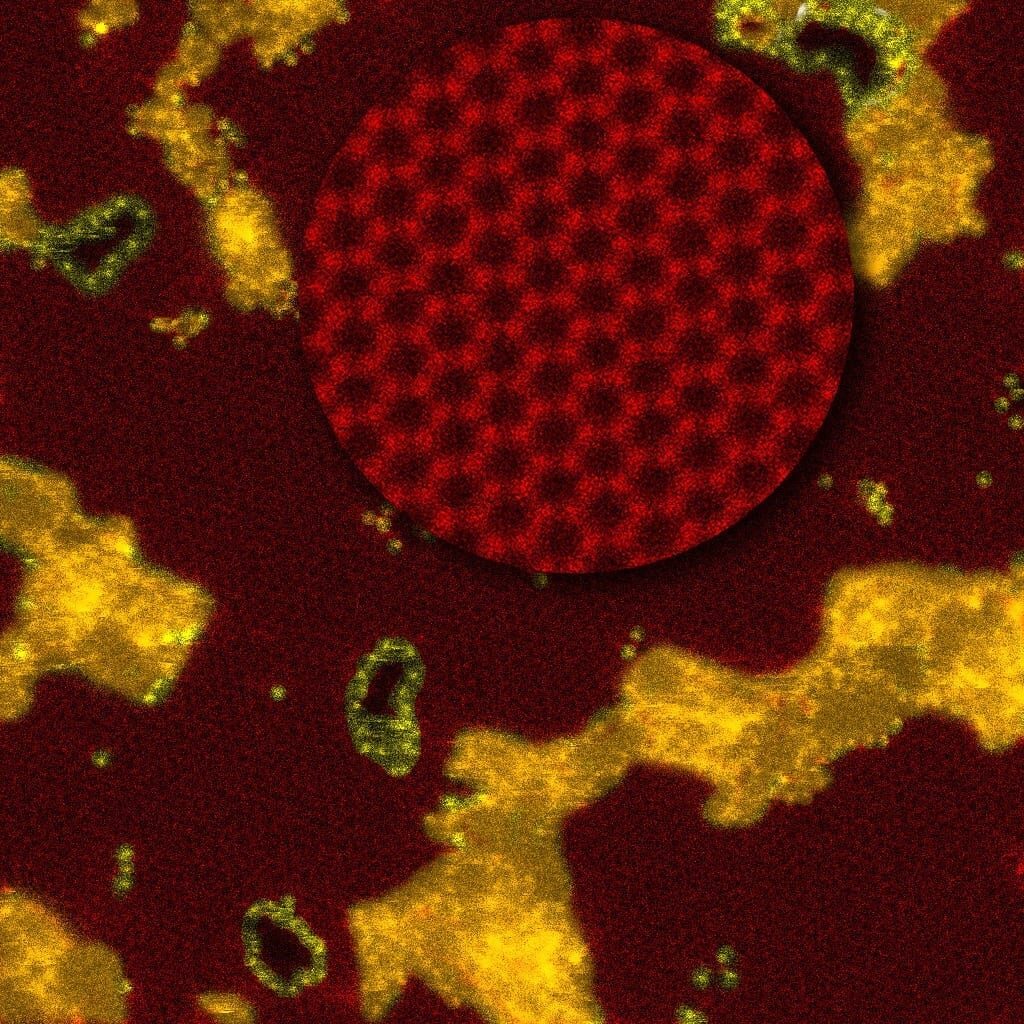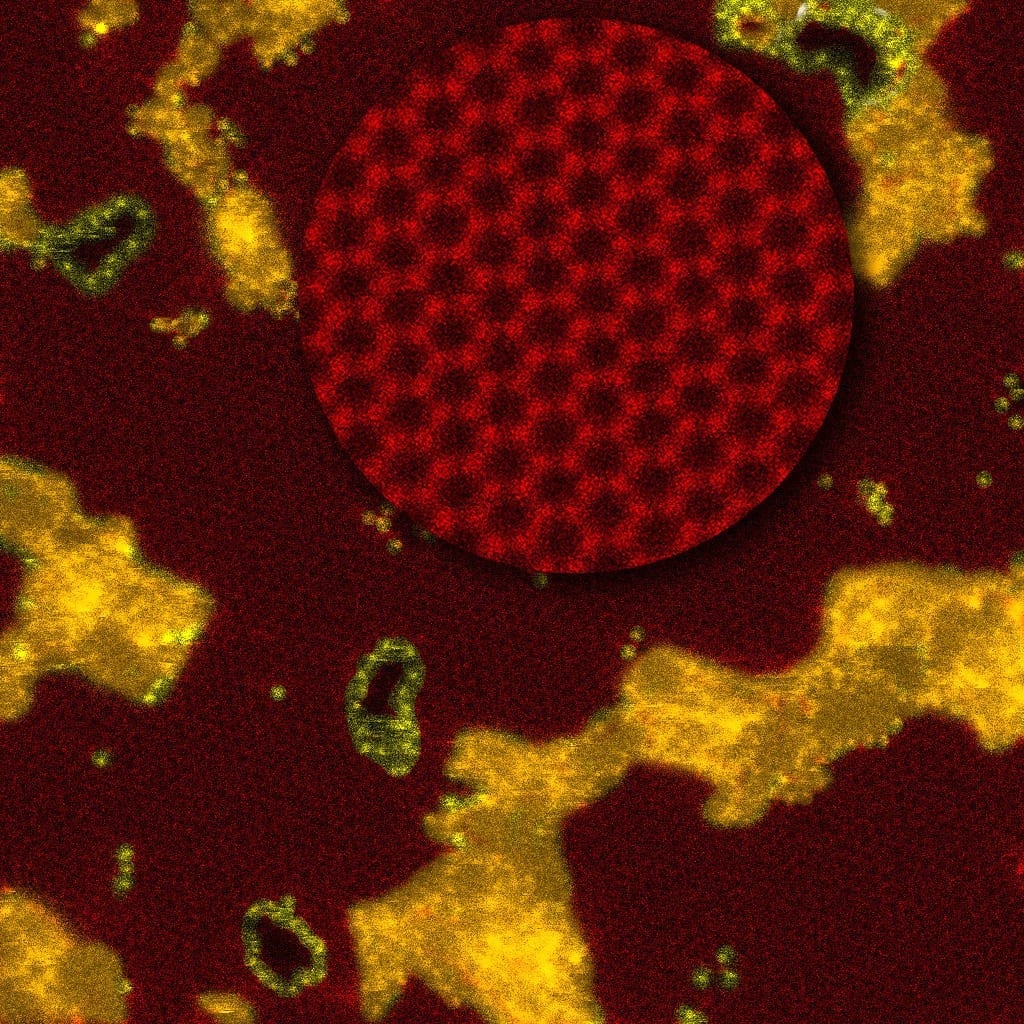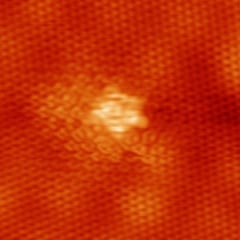
Less than 1 percent of Earth’s water is drinkable. Removing salt and other minerals from our biggest available source of water—seawater—may help satisfy a growing global population thirsty for fresh water for drinking, farming, transportation, heating, cooling and industry. But desalination is an energy-intensive process, which concerns those wanting to expand its application.
Now, a team of experimentalists led by the Department of Energy’s Oak Ridge National Laboratory has demonstrated an energy-efficient desalination technology that uses a porous membrane made of strong, slim graphene—a carbon honeycomb one atom thick. The results are published in the March 23 advance online issue of Nature Nanotechnology.
“Our work is a proof of principle that demonstrates how you can desalinate saltwater using free-standing, porous graphene,” said Shannon Mark Mahurin of ORNL’s Chemical Sciences Division, who co-led the study with Ivan Vlassiouk in ORNL’s Energy and Transportation Science Division.
“It’s a huge advance,” said Vlassiouk, pointing out a wealth of water travels through the porous graphene membrane. “The flux through the current graphene membranes was at least an order of magnitude higher than [that through] state-of-the-art reverse osmosis polymeric membranes.”
Current methods for purifying water include distillation and reverse osmosis. Distillation, or heating a mixture to extract volatile components that condense, requires a significant amount of energy. Reverse osmosis, a more energy-efficient process that nonetheless requires a fair amount of energy, is the basis for the ORNL technology.
Making pores in the graphene is key. Without these holes, water cannot travel from one side of the membrane to the other. The water molecules are simply too big to fit through graphene’s fine mesh. But poke holes in the mesh that are just the right size, and water molecules can penetrate. Salt ions, in contrast, are larger than water molecules and cannot cross the membrane. The porous membrane allows osmosis, or passage of a fluid through a semipermeable membrane into a solution in which the solvent is more concentrated.
“If you have saltwater on one side of a porous membrane and freshwater on the other, an osmotic pressure tends to bring the water back to the saltwater side. But if you overcome that, and you reverse that, and you push the water from the saltwater side to the freshwater side—that’s the reverse osmosis process,” Mahurin explained.
Today reverse-osmosis filters are typically polymers. A filter is thin and resides on a support. It takes significant pressure to push water from the saltwater side to the freshwater side. “If you can make the membrane more porous and thinner, you can increase the flux through the membrane and reduce the pressure requirements, within limits,” Mahurin said. “That all serves to reduce the amount of energy that it takes to drive the process.”
Graphene to the rescue
Graphene is only one-atom thick, yet flexible and strong. Its mechanical and chemical stabilities make it promising in membranes for separations. A porous graphene membrane could be more permeable than a polymer membrane, so separated water would drive faster through the membrane under the same conditions, the scientists reasoned. “If we can use this single layer of graphene, we could then increase the flux and reduce the membrane area to accomplish that same purification process,” Mahurin said.
Read more: ORNL-led team demonstrates desalination with nanoporous graphene membrane
The Latest on: Desalination
[google_news title=”” keyword=”Desalination” num_posts=”10″ blurb_length=”0″ show_thumb=”left”]
via Google News
The Latest on: Desalination
- Kalba desalination plants continue operating consistentlyon April 26, 2024 at 10:29 am
The Sharjah Electricity, Water, and Gas Authority (SEWA) in Kalba assures its subscribers of the uninterrupted operation of its desalination plants, which maintain high reliability. Specialised ...
- Desalination plant behind scheduleon April 25, 2024 at 3:05 pm
A delay in delivery, damage during transit and fouling issues during testing have pushed the desalination plant completion date into 2025.
- MIT Makes Waves with Light-Powered Water Vapor Revelation, Could Change Climate Science and Solar Desalinationon April 25, 2024 at 2:21 pm
MIT researchers discover that light, not just heat, can cause water to evaporate, possibly impacting climate science and drying technologies.
- Desalination, what are the facts?on April 25, 2024 at 5:01 am
One thing you can count on is that any project, large or small, will attract an organisation or individuals to protest. It’s a way of life for some people. The project for a desalination plant in ...
- TCEQ hears from opponents and supporters of Corpus Christi desalination planon April 24, 2024 at 8:37 am
People in Corpus Christi could be the first in Texas to drink treated seawater. Water scarcity in the state is a growing crisis, and ocean desalination is being touted as a solution. But community ...
- New Desalination Technology Promises Freshwater Cheaper Than Tap Wateron April 23, 2024 at 3:31 pm
In a world where access to clean drinking water is becoming increasingly scarce, a team of engineers from MIT and Shanghai Jiao Tong University in China have developed a game-changing solution. Their ...
- About 100 people came to state officials to talk desalination. Here's what they said.on April 20, 2024 at 1:07 am
A meeting for the public to speak on a proposed desalination plant brought about 100 people to the city's convention center. Tensions were high.
- Contentious TCEQ meeting allows all sides to be heard on seawater desalinationon April 19, 2024 at 11:51 am
TCEQ held a much anticipated public comment meeting at the American Bank Center on Thursday. The City of Corpus Christi's Inner Harbor Seawater Desalination Plant was the subject of discussion.
- Barcelona is banking on a floating desalination plant to fight drought in northeastern Spainon April 19, 2024 at 7:00 am
Local authorities say it is a more economical and environmentally sustainable solution than shipping in water.
- Barcelona to get floating desalination plant to help fight drought in northeastern Spainon April 18, 2024 at 8:06 am
BARCELONA, Spain (AP) — Spain’s drought-stricken region of Catalonia will install a floating desalination plant to help the city of Barcelona guarantee its drinking water supply, regional authorities ...
via Bing News











